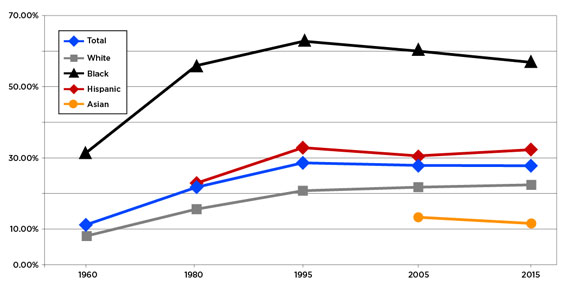How Many Children Won’t Buy a Gift for Dad?
2 min read
Date Published: 06/14/2016
Last Updated: 11/10/2021
National Fatherhood Initiative Blog / Latest Articles
2 min read
This post originally appeared on The Huffington Post.
As Father’s Day 2016 approaches, it’s time to take stock of how many children won’t experience the joy of giving their dad a gift and the smile, hug and kiss that follows.
More than 24 million children, 1 in 3, grow up without their biological father. That’s enough children to populate New York City nearly three times.
Perhaps you wonder whether the number is still bleak when considering that so many children today live in blended or adoptive families. It’s still bleak. More than 20 million children, slightly more than 1 in 4, grow up without a biological, step or adoptive father.
Nevertheless, there is some good news in the battle against father absence as reflected in the chart below.
Percentage of Children Living in Father-Absent Homes: 1960 - 2014
According to the U.S. Census Bureau, the percentage of children in the U.S. living without a dad began to soar in 1960. It rose unabated until 1995 when it suddenly hit the skids—sort of. For every five-year period from 1960 to 1995, the percentage rose. Since then, it has fallen and risen like clockwork. The result is a hold-steady pattern of 27.5 percent.
The good news is that the percentage of Black and Hispanic children living without a dad has fallen in the past 25 years. The drop for Black children from 62.8 to 56.9 percent is heartening because these are the children most likely to live without a dad. The drop for Hispanic children—ever so slight from 32.9 to 31.9 percent—is encouraging nonetheless. Even more good news is the percentage of Asian children living without a dad—tracked by the Census Bureau since 2005—has also fallen from 12.8 to 11.5 percent.
Now, you might wonder which children account for holding the overall percentage steady. It’s White children. Although less affected as a group by father absence than are Black and Hispanic children, a greater percentage of White children today (22 percent) live without a dad than in 1995 (20.8 percent).
What so many people fail to realize is White children make up more than half of all the children living without a dad. Indeed, 58.7 percent of children living without a dad are White.
Father absence is an enemy that wages a color-blind battle. It affects children of every race and ethnicity. It affects children in urban and rural areas. It affects every state and community. It wages a battle everywhere that leaves in its wake a range of poor outcomes for children, families and communities that include poverty, drug and alcohol abuse, poor academic performance, criminal behavior and suicide.
While we have held the line for the past quarter century, we must now push father absence back from whence it came.
Are you a dad looking for help or are you interested in volunteering to help fathers and families? Please visit our Fatherhood Program Locator™ and enter your city and state on the map to find programs and resources in your community.
This post originally appeared on The Huffington Post.
Date Published: 06/14/2016
Last Updated: 11/10/2021
Download the ebook to learn how to create fatherhood initiatives that engage every sector of community life.

Train Your Staff
Fatherhood Programs
Fatherhood Data
© 2025 National Fatherhood Initiative®. All rights reserved.